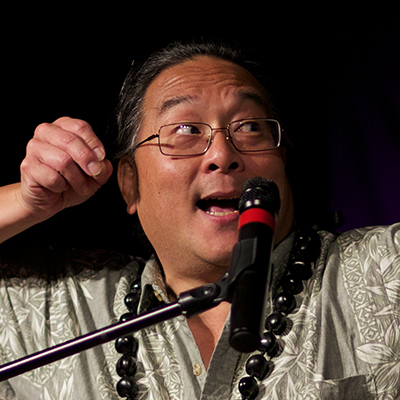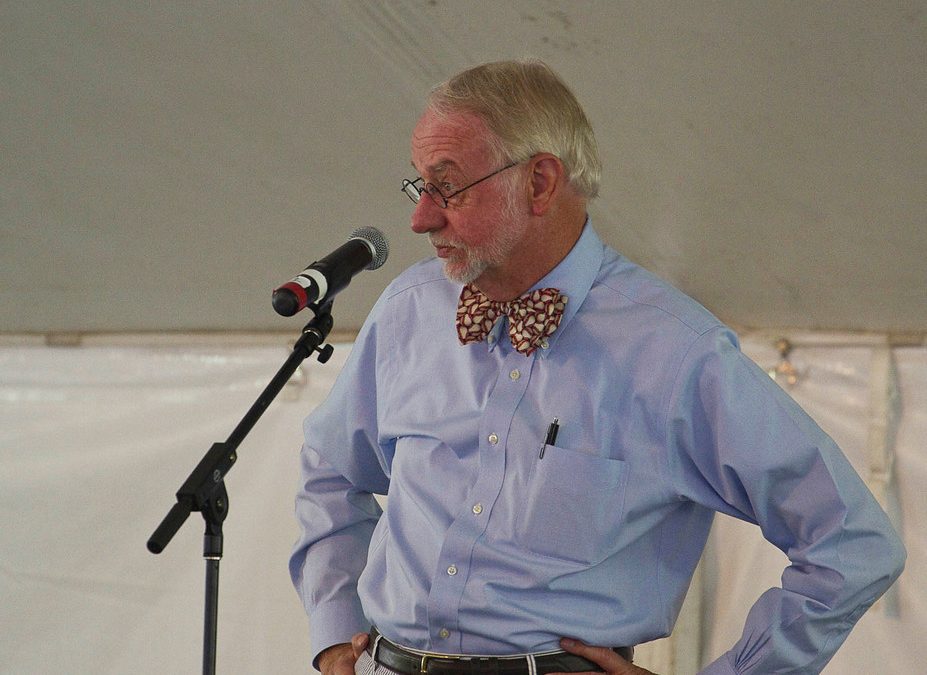
by Sharon Haddock | Aug 16, 2021 | Blog, Featured, Festival, Scheduled, Storytellers
Storyteller Alton Chung believes in connecting with others.
When he tells a story, he is 100 percent present—not worrying about dinner or laundry or bills.
“It is my belief that in our current society, we don’t get much of that kind of focused attention,” he explains.
“We are too busy checking our phones or thinking up a response to something someone said, instead of truly listening to them.
“I believe that there is a human need, a hunger for that level of connection.
“When I perform in a school and am present, I have observed that kids react to that.”
Chung has told stories for 18 years, stories from the Japanese experience in World War II, Asian folktales from around the Pacific Rim, and stories based on the Hawaiian Monarchy.
He got into storytelling somewhat by accident.
“I got into storytelling because I took a class from a local bookstore. I used to live in a small town in Oregon and I knew the owner of the local bookstore. I was reading his newsletter in his shop and asked him about an ad for a storytelling class. He said he had found a Post-It note on his desk with all the info about the class. He put it into his newsletter and then got a call from the lady on the note. She said she guessed she was teaching a class. It turned out that the Post-It note had been floating around on his desk for a year.”
He took the class, told a story that impressed the teacher, and it has been a wild ride since.
“I believe that most of us have learned to some extent to close ourselves off to protect ourselves from anyone who might want to do us harm. I have observed that it is difficult to connect with anyone when I am hiding behind my shields,” Chung said. “There is a heart connect, which is established when I lower my defenses, open myself up, and feel into the audience.
“It is a matter of relaxing, trusting and opening myself up to what is there. I focus on being present and try to look into the eyes of everyone in the audience.
“It is scary and thrilling at the same time.”
![3 Storytelling Tips for Teachers]()
by Courtney Burns | May 1, 2018 | About Storytelling, Scheduled
 The school year is winding down, so we thought we would take a moment to thank all of our hard-working teachers by republishing an article about storytelling in the classroom. Thanks for all of your hard work, dedication, sacrifice, creativity and love.
The school year is winding down, so we thought we would take a moment to thank all of our hard-working teachers by republishing an article about storytelling in the classroom. Thanks for all of your hard work, dedication, sacrifice, creativity and love.
Tips to enhancing your storytelling in the classroom.
The key to making any lesson go from interesting to memorable is a story. A carefully chosen, well-timed story can help a student understand and remember the lesson, and – more importantly- understand how to apply the lesson to their lives. Researchers have found that a human brain can retain more information if it is given in story form then if it is given through a list of unrelated facts.
The case in point I want to share comes from my own life, but here’s a little warning. Since Halloween is coming up and the Timpanogos Storytelling Institute will soon be holding its Hauntings competition, I feel it’s an appropriate time to share this story. One day in my high school English class we were reviewing our vocabulary words for the week and our teacher asked us, “What does paranoia mean?” After one student explained the dictionary definition she had written down on her homework page the night before, the teacher then asked, “Now, what does that word really mean?” We were stumped. She explained that a dictionary may give us a definition of a word, but to really understand a word we have to experience it. Then she began to tell us the story of how she came to understand what paranoia really meant. It happened while she was on a trip to the USSR in the late 1970s. The tour bus full of Americans were warned ahead of time that they would be carefully watched by KGB agents while they were in the country and that it was likely that all telephone calls would be monitored as well. They were also told not to keep any valuables in their hotel rooms and to keep an eye out for pickpockets as their US passport was highly prized in the country at that time. Her feeling of paranoia mounted over the days as she would catch a glimpse of someone watching her or she would hear a click on the other end of the phone. One day, while in Moscow, she went into a women’s rest room. As she entered she carefully looked under the stall doors to see if anyone was there. She noticed a pair of shoes in the far stall and decided to use a stall closer to the entrance. Just as she shut her stall door she heard the rest room door open and someone walked in, walked the length of the stalls, and then turned and stopped in front of her door. At about the same time, the door to the other stall opened and she heard a second set of footsteps. Unsure of what to do, she put her back against the door to hold it shut. Just then, something came over the top of the stall door, hitting her head and knocking her to the floor unconscious. When she awoke she found that her purse had been stolen, but thankfully she was unharmed, except for the nasty bump on her head. “And that’s what paranoia is,” she told her mesmerized class. I’ve never forgotten that lesson. The word “paranoia” would’ve been just another vocabulary word if it hadn’t been for her story.
So here are three ideas that you can use to incorporate stories into your curriculum, whether you teach in a school setting, at church, or in your home.
1. Keep it short and focus on how the story relates to the lesson. Don’t meander off in your story and bring in irrelevant sidebars. A concise story is much more likely to make an impact and be remembered than a rambling one.
2. Get your students involved. Have them think of their own stories in relation to the lesson material. It is one thing for a student to have an intellectual understanding of a topic, but when they can have an emotional understanding as well, then you know that the lesson has become theirs. They can use their head and their hearts to understand. For instance, just this morning I was teaching a student about symbols, and I used the example of “instrument in the hands of God.” (Obviously this wasn’t a public school situation.) We got our heads around it by talking about the word “instrument” and all that is associated with it, but to get our hearts wrapped around it I asked him to think of a time when he had been an instrument and what that felt like. I then told him a story about a time I felt like I was an instrument. The story made an impact on him, and he was able to think of an example in his own life.
3. There are ways to incorporate stories into almost every subject matter that you might teach. I have taught English, history, and creative writing, which all naturally lend themselves to stories, but I was able to incorporate stories into my science curriculum as well. Stories can be used as hooks to begin a lesson, but they can also be used to help the students organize information and create mental file folders. A story about the constellation of Orion might begin a unit on astronomy and help a student to file away the facts about the solar system.
Albert Einstein said, “Imagination is more important than knowledge.” Let’s help our students use their imaginations to gain knowledge by incorporating more storytelling into our lessons.

by Courtney Burns | Nov 4, 2013 | About Storytelling, Scheduled, Timpanogos
We love our sponsors! Timpanogos Storytelling simply would not survive without them.

Today, we would like to congratulate our superstar sponsor, Kaleidoscope Pictures. They were just awarded a Regional Emmy in the category Arts/Entertainment – Program/Special for their program with BYU Broadcasting, The Song That Changed My Life: Howard Jones.
According to their website, “The Song That Changed My Life is a chance for artists to tell the story they want to tell, to reach beyond the typical gossip and “how did you pick your band name?” questions. It’s their chance to take us backstage, back home, down the creative well and into their roots.” If you haven’t yet checked out this show you really should. It is a great way to get down to the core of some great people making some great music. See more at: http://thesong.kaleidoscopepictures.com/about/#byutv
Kaleidoscope first connected with Timpanogos Storytelling in 2011 when they went out to scenic Ocracoke Island, North Carolina, to film What’s Your Story? A Donald Davis Workshop. They filmed the workshop process, the amazing participants, and of course, the storyteller. Along the way, they fell in love with storytelling, and have been a generous sponsor ever since. They have given countless hours of filming, production, and support through the past several years, always going above and beyond what we could hope to ask for.
To Adam, Russ, and all our friends at Kaleidoscope Pictures, congratulations!
by Courtney Burns | Sep 27, 2013 | About Storytelling, Scheduled
It was such a wonderful year for the Timpanogos Storytelling Festival and so it is no wonder that we are having a hard time officially saying goodbye. But, alas, all things must come to an end—and besides we have some fun things coming up in the next couple of months. As we make our final goodbye, we offer this look back in pictures at the 24th annual Timpanogos Storytelling Festival:
All photos were taken by two of our fantastic volunteers: Laren Helms and Tom Thurston.

by Courtney Burns | Sep 24, 2013 | Scheduled
 It is Saturday, 6 pm at the Orem Public library and I have just picked up the last of the entry forms for our new “Hauntings” storytelling competition. The library is now closed and I head back to my car so excited for the contest next weekend I can hardly stand it. I tuck the entry forms under my arm. As I approach my car I notice it is partially engulfed in a red gelatinous mass. Thinking this is some sort of joke I approach the red-shiny goo just too touch it and it suddenly reaches out as if to grab me.
It is Saturday, 6 pm at the Orem Public library and I have just picked up the last of the entry forms for our new “Hauntings” storytelling competition. The library is now closed and I head back to my car so excited for the contest next weekend I can hardly stand it. I tuck the entry forms under my arm. As I approach my car I notice it is partially engulfed in a red gelatinous mass. Thinking this is some sort of joke I approach the red-shiny goo just too touch it and it suddenly reaches out as if to grab me.
No, it doesn’t want to grab me, exactly. It is actually trying to grab the contest entry forms from my hand! I keep the papers away from the red sticky arm. I begin to back up and run to get some help, but it is too late. An icy tentacle has wrapped around my waist and rebounded me into direction of the car. I am now stuck to the car like a fly on flypaper or a rat on a glue board. I am trying to keep the registration forms away from the approaching mass of goo, but to no avail. The red goo had grown around my whole body and began to creep across my outstretched arm. I began to understand how a toddler moves when he is keeping a prized cookie away from a determined parent. I held the registration forms as far away as I could from the encroaching evil gelatin.
“Why?” I yelled. “You don’t need these! I do!” I tried to scream for help, but apparently I didn’t practice enough screaming as a child. Nobody came.
Cold began to creep over my neck, scalp, and face. With all of my strength I quickly opened the contestant envelope and memorized the names. Panic set in as the slime entered my nose and mouth. I am so claustrophobic! I had to drop the registrations.
I awoke on the ground next to my car. A library staff member was shaking me. “Are you all right?” I checked all of my limbs. Everything was in place. I glanced around and there were no registration papers, anywhere. I brushed myself off and got in the car. At least I had remembered to look at the names. My eyes caught something unusual as I put the key in the ignition. On the dashboard was a note written in red slime, “See you on Saturday.”
I just don’t know whether I need to warn the “Hauntings” contestants or not.

by Courtney Burns | Sep 11, 2013 | Scheduled
 A few days ago, I returned to Colorado with my family from another extraordinary experience at the Timpanogos Storytelling Festival. Twenty-four years of excellence is no small feat. Everyone who ever has been or is currently involved in the festival or mid-winter conference can be very proud.
A few days ago, I returned to Colorado with my family from another extraordinary experience at the Timpanogos Storytelling Festival. Twenty-four years of excellence is no small feat. Everyone who ever has been or is currently involved in the festival or mid-winter conference can be very proud.
I am a storyteller and teacher among many other things. Most of my life, my telling of personal anecdotes was limited to the dinner table or my classroom, usually to make a point. I never thought I’d have personal tales to tell because I simply didn’t live Donald’s life. Those kinds of things didn’t happen to me. I was satisfied listening to Donald, recognizing the people in his stories, the shared values or ideas we have in common and letting his memories trigger alternating laughter and tears in me, often in rapid succession.
Over the years, I had the privilege of working with Donald in various workshops and always came away the richer for it. I used many of the techniques I learned from him with great success in my classroom and in inservices I conducted for parents, teachers and students of all ages.
A few years ago, it dawned on me that my next logical professional move was to step out of my comfort zone and work on my own personal stories with Donald. What I learned serves me professionally, in storytelling, teaching and the students with whom I work; and also personally in my appreciation of family, friends, colleagues, and myself. The perspectives I gained around noticing details and deepening awareness of life events: gratitude, laughter, missteps, joys, tragedies, personalities, humor and how they are interrelated continue to make connections for me in profound ways. I listen, write and speak differently, especially with the people I love. Those scraps of moments in our lives create beautiful tapestries if we will but stand back and recognize them. Yes, there are significant stories in each of our lives. As my friends at Timpanogos say, the stories are “Yours, Mine and Ours.” We may or may not ever perform them in front of a storytelling audience like Donald does, but taking the time to craft them and tell them to our families and others; to learn to listen deeply, thereby honoring the stories others have to tell us can only create profound levels of understanding that will serve us all in time. Kathryn Tucker Wyndham once told me, “We must tell our stories.” She was talking about families, people in trouble, people sharing joy, different cultures, different generations and humanity itself. This is a path to that directive.
If I can encourage even one person to be involved in one of Donald Davis’ retreats, I know I will be perpetuating a rare gift in families and in classrooms everywhere because the word will necessarily spread. This work of sharing our stories is just too important, just too good to be quiet about. I heartily encourage anyone to do so. The retreat was mind-opening for me on many personal and professional levels.
Donald is not a sage on the stage kind of teacher. His style is much more Socratic. There is so much depth to be gained from listening to the stories shared, to Donald’s responses, to the questions he asks, to the questions and responses from other individuals in the group itself, and the experience of our own responses to all of the above.
My experience with the retreat was that the meat of the learning goes far beyond the incredible insights Donald shares with his words. Much of the learning opportunity lies in the marriage of Donald’s sensitive experience, knowledge and wisdom shared with the stories told, and the responses and insights from other individuals in the group. It’s a very thoughtful process that requires time and trust. It’s much more than a solitary learning moment. It is much more than a class. It truly is a retreat with all the nourishment that implies.
I wholeheartedly encourage anyone to attend Donald’s retreat. I promise you, you will learn and you won’t be disappointed.
Fondly,
Anita Strickbine
Basalt, Colorado








